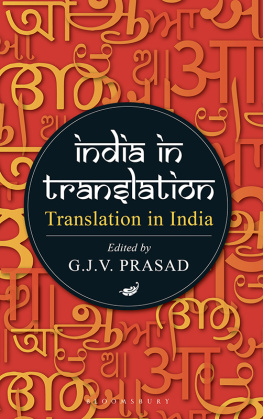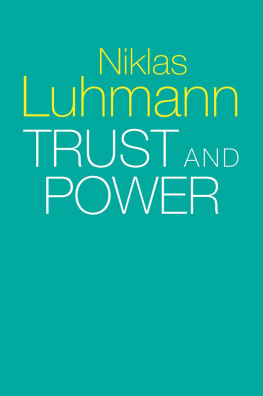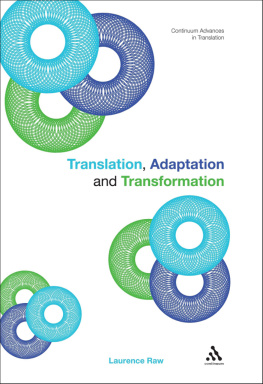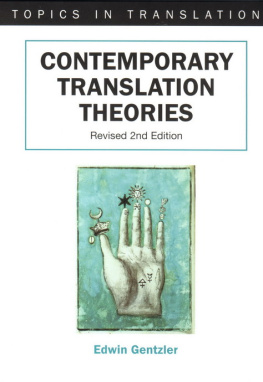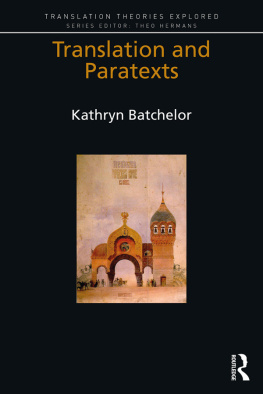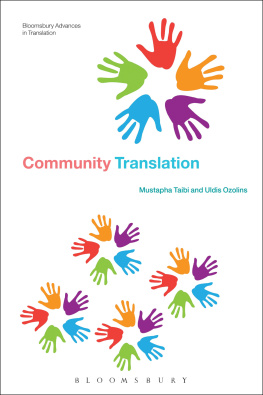Figures
Tables
Introduction
The present book is in line of the research conducted in a series of books published by one of the leading sociologists of the twentieth century Niklas Luhmann (192798). Among his numerous publications (see bibliographies of Luhmanns works in German in Baraldi, Corsi, and Esposito 1997 and of his works translated into English in Moeller 2006), there are two major general expositions of his social systems theory (SST) and a series of what may be called case studies, that is, studies of individual social subsystems. The former group is comprised of general SST works: Soziale Systeme: Grundriss einer allgemeinen Theorie (1984, in English translation: Social Systems , see Luhmann 1995) and Die Gesellschaft der Gesellschaft (1997, The Society of Society ). The latter group includes monographs on the economy ( Die Wirtschaft der Gesellschaft , 1988), science ( Die Wissenschaft der Gesellschaft , 1990), law ( Das Recht der Gesellschaft , 1995), art ( Die Kunst der Gesellschaft , 1995), religion ( Die Religion der Gesellschaft , published post-humously by Andr Kieserling, 2000), education ( Die Erziehungssystem der Gesellschaft , published posthumously by Dieter Lenzen, 2001) and others (see also Runkel and Burkart 2005, 7, 11). The second type of Luhmanns publications, where SST is applied to individual social function systems, serves as a model for the present monograph, and, consequently, the latter aspires to continue Luhmanns original series by adding a systemic description of one more social function systemthe translation system.
Although there have been attempts to describe translation in terms of SST (see an overview in Section 2.1), the subject has not been treated in any satisfactorily comprehensive fashion. This is the ambition of this researchto go beyond simplified and cursory outlines of the applicability of only the major SST concepts and to explore Luhmanns theory in all its inspiring complexity.
In a nutshell, Luhmann considered society as a self-reproducing (autopoietic) system surrounded by an environment. The system is composed of subsystems. In modern society such subsystems include the economy, law, politics, art, religion, mass media, and education. The list is by no means exhaustive. Luhmanns social system theory allows and indeed prompts its application to more than these subsystems (see Berg and Schmidt 2000; Seidl and Becker 2005; Seidl 2005; Ihlen, Ruler, and Fredriksson 2009, 187211). Any social formation may be studied from the standpoint of SST as long as it claims to be or can be described as a self-reproducing unity. Translation is no exception and this is what I intend to demonstrate in this study.
In the above said, there is already a great deal to define and explain: What exactly is a social system? What is the difference between system and subsystem? What is environment and what is its relationship with the system? I will discuss all these issues in due course and apply these notions to translation. By and large, in my application of SST to translation, I will follow the pattern set by Luhmann in the mentioned series of books on the economy law, politics, art, religion, and education as social systems. More specifically, I will describe translation qua system with its internal mechanisms and then its relationship with other social units.
Needless to say, the field of possibilities to apply Luhmanns SST as well as other sociological and systems theories to translation is vast, and one cannot hope to cover it in one monograph. Here I would like to quote Gregory Bateson who, having adumbrated in a book the line of his research, warned the reader: Some of these questions are touched upon in the essays, but the main thrust of the book is to clear the way so that such questions can be meaningfully asked (1972, xviii). In this study, mine is a similar task. While going deeper, than any existing relevant attempts in translation studies, into Luhmanns SST and its sources, I do not claim to have exhausted the subject, Luhmanns social theory being so rich and many-faceted that it is impossible to consider all what it has to offer in any single study.
VIRGIL OR BEATRICE, BUT DEFINITELY AN ASTONISHING TRANSLATOR
Society and social laws lay hid in night.
God said: Let Luhmann be and all was light.
Dietrich Schwanitz
If there is no place like our present homelessness away from home, then it is Luhmann who can best guide us in this ever-expanding wilderness.
William Rasch
Luhmann came into sociology when postmodern theorizing came to a kind of bifurcation point, a state of instability, after which a systems self-organization is unpredictable. After the disappearance of the transcending observer, metanarratives, that is, grand theories encompassing and unifying modern historical and social experience and attempting to explain it, were declared bankrupt, and the project of creating such theories was abandoned. Since there is no such external observer, whatever observation is made, it is inevitably made from inside (the world) and cannot claim to suggest more than a representation among many other possible and existing representations. Admitting that no one binding representation of society is any longer possible, Luhmann did not assess the situation in exclusively negative or critical terms. He believed there was still something to be said about our highly differentiated and fragmented world. The end of metanarrative did not mean, for Luhmann, the end of theory, but rathera challenge to theory (Knodt 1995, xxi). And he took up the challenge.
Although describing himself as a sociologist, Luhmann virtually broke with contemporary sociology which, in his opinion, showed deficit in theory and resorted to piling up data and uncritical raking through classics (2009, 11). He saw a way out in turning for inspiration to other disciplines. He bravely exploded sociological boundaries when he combined social theory with the most recent scientific theoretical ideas, notably physics, information theory, biology, general systems theory, etc.
Non-sociological domains enabled Luhmann to come to grips with the growing rationalization and pluralization of our disenchanted world, picking up where Max Weber left off (Rasch 2000, 2). This is where Luhmann and another giant figure of modern sociological thought Jrgen Habermas are drastically different (Habermas and Luhmann 1975; Edgar 2006, 80, 86, 1512; Donati 2011, 21). Luhmann does not hope to regain the unity of reason and, ultimately, the world. Rather, in Weberian fashion, he participates in the operations and mitosis-like self-divisions of modern rationality by describing how those operations function (Rasch 2000, 11). Habermas, on the contrary, sees his mission in finding a unifying basis for the world which has had a great fall but which might, as Habermas seems to believe, be put together again. This seems to be the ultimate goal of Habermass critical stance. That is why he insists on the importance to balance instrumental action with communicative action. That is how he hopes to regain the territory lost by the Lifeworld pushed on all sides by the colonizing systems (Habermas 1989a).
Luhmann paints a warts-and-all portrait of the de-centered and demystified world of modernity. He does not engage in either criticism or building a new Noahs arc of a sort. In his SST, Luhmann presents the world as a multitude of equally unequal systems. Specifically, he is interested in self-(re)producing, or autopoietic, systems. Each system, being operationally closed, is surrounded by an environment. Steering clear off the rocks of solipsism and following von Foerster, Luhmann recognizes that autopoietic systems are not only closedbecause, although they produce their elements themselves and out of themselves, they obtain necessary ingredients from the environment. Being a sociologist, he is primarily concerned with social systems, communication-based self-reproducing systems.



